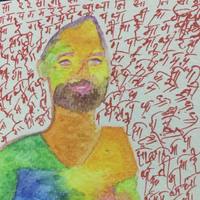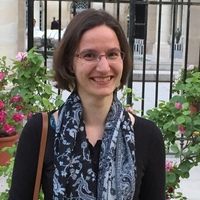
Matthew Rahaim
Matthew Rahaim is a scholar and creative musician working in the fertile borderlands of raga, musical philosophy, and the American experimental tradition. He is a Hindustani vocalist (Gwalior gayaki), an ethnomusicologist (voice, ethnography, participation, phenomenology), an improviser (analog synthesizers, voice, improvised conduction) and a composer (new instruments, event scores, drone/dronebreaking, experimental counterpoint.) Matthew's recent creative work has appeared at the Goldstein Museum of Design, the Wakpa Triennial, Drone Not Drones, and The Great Beyond Festival.
Matthew's ethnomusicological research focuses on Hindustani music, practices of listening, and the mysteries of voice. His book Ways of Voice: Vocal Striving and Moral Contestation in North India and Beyond (2021) is an ethnographic investigation of various traditions of voice cultivation and ethical self-work in the Hindustani vocal ecumene, from Bollywood to Qawwali to Sufi Pop. His first book, Musicking Bodies: Gesture and Voice in Hindustani Music, (2012) dealt with the tacit bodily disciplines passed down through generations of Hindustani vocalists. Both are grounded in the ethnography of performance. Recent philosophical essays include "Not Just One, Not Just Now: Voices in Relation" in the Oxford Handbook of Phenomenological Ethnomusicology and "Object, Person, Machine, or What: Practical Ontologies of Voice," in the Oxford Handbook of Voice Studies. His research and review articles have appeared in the Journal of Asian Studies, Theory in Ethnomusicology Today, World of Music, Asian Music, Yearbook for Traditional Music, Gesture, The Oxford Handbook of Voice Studies, Music and Empathy, and New Perspectives on Music and Gesture. He also is the author of the article "Music" in the Brill Encyclopedia of Hinduism.
Matthew is currently working on several projects that bridge creative music and scholarly inquiry. Between a Barrel and a Heart is a suite of pieces for new instruments built out of decommissioned police rifles by sculptor Pedram Baldari, drawing on the poetry of Faiz Ahmed Faiz and the Orphic science fiction of American novelist Samuel R. Delaney. In Neumatic Migrations, Matthew apprentices himself to a single migratory American Robin who returns to his backyard year after year, improvising on an expansive repertoire of melodic gestures. Nine Ragas is both a method book and a grounded speculative exploration of the phenomenology of raga. What Drone Consciousnesses Is Is Is explores the temporality and speculative politics of the American drone tradition through archival research and interactive analog synthesisis. Matthew is also working on a book of event scores and poetry, Improvising Relationality, experimenting with practical ways of performing togetherness and distance, in empathic intimacy and vulnerable alterity, exploring the relational play of mutual dependence and mutual freedom.
Other interests include voice studies, bhakti and Sufi poetry, the anthropology of ethics, practical ontology, Keplerian music theory, the interface of raga and maqam, practices of listening, birdsong, and speculative harmonics.
Matthew's teaching spans improvisation, scholarly research, composition, and contemplative practice. Courses include Improvising Relationality; Raga; Sonic Ecology; Hindustani Musics; What do Voices Do?; and Practices of Listening. He trained in the Gwalior lineage of raga music under his guru, Laxman Krishnarao Pandit. Other influential teachers include Jon K. Barlow, Alvin Lucier, Molly Sturges, Anthony Braxton, Veena Sahasrabuddhe, Myra Melford, Bonnie Wade, and Vasudha Dalmia. Matthew believes in the liberal arts, and he believes in going slowly.
Matthew's ethnomusicological research focuses on Hindustani music, practices of listening, and the mysteries of voice. His book Ways of Voice: Vocal Striving and Moral Contestation in North India and Beyond (2021) is an ethnographic investigation of various traditions of voice cultivation and ethical self-work in the Hindustani vocal ecumene, from Bollywood to Qawwali to Sufi Pop. His first book, Musicking Bodies: Gesture and Voice in Hindustani Music, (2012) dealt with the tacit bodily disciplines passed down through generations of Hindustani vocalists. Both are grounded in the ethnography of performance. Recent philosophical essays include "Not Just One, Not Just Now: Voices in Relation" in the Oxford Handbook of Phenomenological Ethnomusicology and "Object, Person, Machine, or What: Practical Ontologies of Voice," in the Oxford Handbook of Voice Studies. His research and review articles have appeared in the Journal of Asian Studies, Theory in Ethnomusicology Today, World of Music, Asian Music, Yearbook for Traditional Music, Gesture, The Oxford Handbook of Voice Studies, Music and Empathy, and New Perspectives on Music and Gesture. He also is the author of the article "Music" in the Brill Encyclopedia of Hinduism.
Matthew is currently working on several projects that bridge creative music and scholarly inquiry. Between a Barrel and a Heart is a suite of pieces for new instruments built out of decommissioned police rifles by sculptor Pedram Baldari, drawing on the poetry of Faiz Ahmed Faiz and the Orphic science fiction of American novelist Samuel R. Delaney. In Neumatic Migrations, Matthew apprentices himself to a single migratory American Robin who returns to his backyard year after year, improvising on an expansive repertoire of melodic gestures. Nine Ragas is both a method book and a grounded speculative exploration of the phenomenology of raga. What Drone Consciousnesses Is Is Is explores the temporality and speculative politics of the American drone tradition through archival research and interactive analog synthesisis. Matthew is also working on a book of event scores and poetry, Improvising Relationality, experimenting with practical ways of performing togetherness and distance, in empathic intimacy and vulnerable alterity, exploring the relational play of mutual dependence and mutual freedom.
Other interests include voice studies, bhakti and Sufi poetry, the anthropology of ethics, practical ontology, Keplerian music theory, the interface of raga and maqam, practices of listening, birdsong, and speculative harmonics.
Matthew's teaching spans improvisation, scholarly research, composition, and contemplative practice. Courses include Improvising Relationality; Raga; Sonic Ecology; Hindustani Musics; What do Voices Do?; and Practices of Listening. He trained in the Gwalior lineage of raga music under his guru, Laxman Krishnarao Pandit. Other influential teachers include Jon K. Barlow, Alvin Lucier, Molly Sturges, Anthony Braxton, Veena Sahasrabuddhe, Myra Melford, Bonnie Wade, and Vasudha Dalmia. Matthew believes in the liberal arts, and he believes in going slowly.
less
Related Authors
Tejaswini Niranjana
Ahmedabad University
Annelies Andries
Utrecht University
Anaar Desai-Stephens
Eastman School of Music
John Paul Stephens
Case Western Reserve University
Felix Graham
Teachers College, Columbia University
Rachael Lansang
Rutgers, The State University of New Jersey
InterestsView All (38)









Uploads
Books by Matthew Rahaim
http://ethnomusicologyreview.ucla.edu/content/book-review-musicking-bodies-gesture-and-voice-hindustani-music-matthew-rahaim-0
"Indian vocalists trace intricate shapes with their hands while improvising melody. Although every vocalist has an idiosyncratic gestural style, students inherit ways of shaping melodic space from their teachers, and the motion of the hand and voice are always intimately connected. Though observers of Indian classical music have long commented on these gestures, Musicking Bodies is the first extended study of what singers actually do with their hands and voices. Matthew Rahaim draws on years of vocal training, ethnography, and close analysis to demonstrate the ways in which hand gesture is used alongside vocalization to manifest melody as dynamic, three-dimensional shapes. The gestures that are improvised alongside vocal improvisation embody a special kind of melodic knowledge passed down tacitly through lineages of teachers and students who not only sound similar, but who also engage with music kinesthetically according to similar aesthetic and ethical ideals. Musicking Bodies builds on the insights of phenomenology, Indian and Western music theory, and cultural studies to illuminate not only the performance of gesture, but its implications for the transmission of culture, the conception of melody, and the very nature of the musicking body.
Endorsements:
“Ranging authoritatively through the fecund terrain of Hindusthani music, Matthew Rahaim reunites musical sound with the bodies that produce it, refuting the discourses and practices that have kept them apart, and revealing their powerful complementarity. The book is concise, smart, erudite, imaginative, and generous on every page. Raga and tala emerge enriched, performers and theorists find common purpose, and music becomes something even bigger and more profound.”—Michael Tenzer, author of Gamelan Gong Kebyar: The Art of 20th Century Balinese Music
“This book offers new ways of understanding the knowledge embodied in gesture and voice. Moving beyond the idea that gesture is merely metaphoric or extraneous, Rahaim presents approaches for analyzing and interpreting gesture to reveal how it relates to the performing body.”—Tomie Hahn, author of Sensational Knowledge: Embodying Culture through Japanese Dance"
Papers by Matthew Rahaim
It also addresses the political implications of figuring the voice as _one_ and _now_. The irrelational individual-expressivist figuration provides the metaphysical scaffolding for groupist-expressivist figurations of voice, in which homogenous collectivities are understood to speak in unison, cut off from interlocutors, response, or counter point (cut off, that is, from actual sociality.) What political and ethical possibilities might open up by turning from irrelational soliloquy to relational colloquy, among others, in time?
http://ethnomusicologyreview.ucla.edu/content/book-review-musicking-bodies-gesture-and-voice-hindustani-music-matthew-rahaim-0
"Indian vocalists trace intricate shapes with their hands while improvising melody. Although every vocalist has an idiosyncratic gestural style, students inherit ways of shaping melodic space from their teachers, and the motion of the hand and voice are always intimately connected. Though observers of Indian classical music have long commented on these gestures, Musicking Bodies is the first extended study of what singers actually do with their hands and voices. Matthew Rahaim draws on years of vocal training, ethnography, and close analysis to demonstrate the ways in which hand gesture is used alongside vocalization to manifest melody as dynamic, three-dimensional shapes. The gestures that are improvised alongside vocal improvisation embody a special kind of melodic knowledge passed down tacitly through lineages of teachers and students who not only sound similar, but who also engage with music kinesthetically according to similar aesthetic and ethical ideals. Musicking Bodies builds on the insights of phenomenology, Indian and Western music theory, and cultural studies to illuminate not only the performance of gesture, but its implications for the transmission of culture, the conception of melody, and the very nature of the musicking body.
Endorsements:
“Ranging authoritatively through the fecund terrain of Hindusthani music, Matthew Rahaim reunites musical sound with the bodies that produce it, refuting the discourses and practices that have kept them apart, and revealing their powerful complementarity. The book is concise, smart, erudite, imaginative, and generous on every page. Raga and tala emerge enriched, performers and theorists find common purpose, and music becomes something even bigger and more profound.”—Michael Tenzer, author of Gamelan Gong Kebyar: The Art of 20th Century Balinese Music
“This book offers new ways of understanding the knowledge embodied in gesture and voice. Moving beyond the idea that gesture is merely metaphoric or extraneous, Rahaim presents approaches for analyzing and interpreting gesture to reveal how it relates to the performing body.”—Tomie Hahn, author of Sensational Knowledge: Embodying Culture through Japanese Dance"
It also addresses the political implications of figuring the voice as _one_ and _now_. The irrelational individual-expressivist figuration provides the metaphysical scaffolding for groupist-expressivist figurations of voice, in which homogenous collectivities are understood to speak in unison, cut off from interlocutors, response, or counter point (cut off, that is, from actual sociality.) What political and ethical possibilities might open up by turning from irrelational soliloquy to relational colloquy, among others, in time?